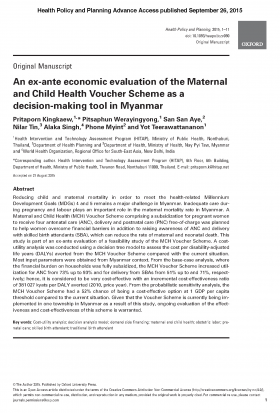This website uses cookies so that we can provide you with the best user experience possible. Cookie information is stored in your browser and performs functions such as recognising you when you return to our website and helping our team to understand which sections of the website you find most interesting and useful.
An ex-ante economic evaluation of the Maternal and Child Health Voucher Scheme as a decision-making tool in Myanmar (2015)

รายละเอียดเพิ่มเติม
Pritaporn Kingkaew,1,* PitsaphunWerayingyong,1 San San Aye,2
Nilar Tin,3 Alaka Singh,4 Phone Myint2 and Yot Teerawattananon1
1Health Intervention and Technology Assessment Program (HITAP), Ministry of Public Health, Nonthaburi,
Thailand, 2Department of Health Planning and 3Department of Health, Ministry of Health, Nay Pyi Taw, Myanmar
and 4World Health Organization, Regional Office for South-East Asia, New Delhi, India
*Corresponding author. Health Intervention and Technology Assessment Program (HITAP), 6th Floor, 6th Building,
Department of Health, Ministry of Public Health, Tiwanon Road, Nonthaburi 11000, Thailand. E-mail: [email protected]
Abstract
Reducing child and maternal mortality in order to meet the health-related Millennium Development Goals (MDGs) 4 and 5 remains a major challenge in Myanmar. Inadequate care during pregnancy and labour plays an important role in the maternal mortality rate in Myanmar. A Maternal and Child Health (MCH) Voucher Scheme comprising a subsidization for pregnant women to receive four antenatal care (ANC), delivery and postnatal care (PNC) free-of-charge was planned
to help women overcome financial barriers in addition to raising awareness of ANC and delivery with skilled birth attendants (SBA), which can reduce the rate of maternal and neonatal death. This study is part of an ex-ante evaluation of a feasibility study of the MCH Voucher Scheme. A costutility analysis was conducted using a decision tree model to assess the cost per disability-adjusted life years (DALYs) averted from the MCH Voucher Scheme compared with the current situation. Most input parameters were obtained from Myanmar context. From the base-case analysis, where the financial burden on households was fully subsidized, the MCH Voucher Scheme increased utilization for ANC from 73% up to 93% and for delivery from SBAs from 51% up to and 71%, respectively; hence, it is considered to be very cost-effective with an incremental cost-effectiveness ratio of 381 027 kyats per DALY averted (2010, price year). From the probabilistic sensitivity analysis, the MCH Voucher Scheme had a 52% chance of being a cost-effective option at 1 GDP per capita threshold compared to the current situation. Given that the Voucher Scheme is currently being implemented in one township in Myanmar as a result of this study, ongoing evaluation of the effectiveness and cost-effectiveness of this scheme is warranted.
Full Text: http://heapol.oxfordjournals.org/content/early/2015/09/25/heapol.czv090.abstract




